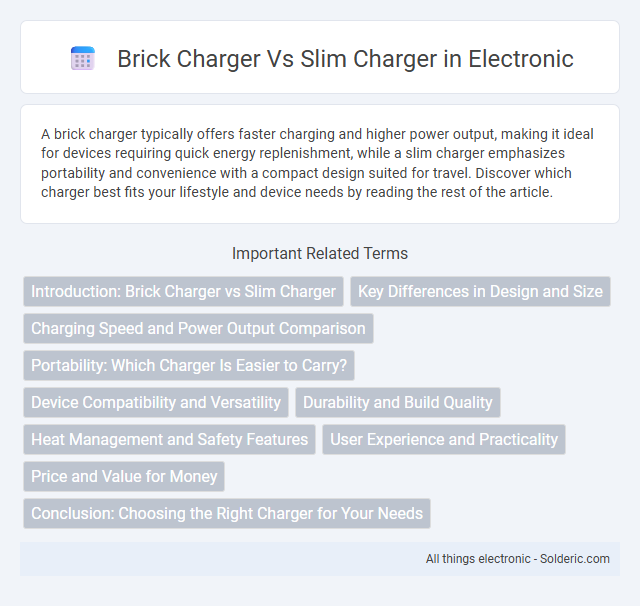A brick charger typically offers faster charging and higher power output, making it ideal for devices requiring quick energy replenishment, while a slim charger emphasizes portability and convenience with a compact design suited for travel. Discover which charger best fits your lifestyle and device needs by reading the rest of the article.
Comparison Table
| Feature | Brick Charger | Slim Charger |
|---|---|---|
| Size | Bulky, larger footprint | Compact, slim profile |
| Portability | Less portable, heavier | Highly portable, lightweight |
| Charging Speed | Generally standard to fast charging | Supports fast or ultra-fast charging |
| Power Output | Typically 5W to 18W | Often ranges 18W to 65W or more |
| Heat Dissipation | Better heat management due to size | May heat up more due to compact design |
| Durability | More robust, less prone to damage | More fragile due to thinner design |
| Use Case | Ideal for home and office use | Perfect for travel and on-the-go charging |
| Price | Generally lower cost | Usually higher price due to technology |
Introduction: Brick Charger vs Slim Charger
Brick chargers typically offer higher power output and faster charging speeds due to their larger size and advanced components. Slim chargers, designed for portability and convenience, prioritize compactness and lightweight design but may deliver lower wattage and slower charging performance. Choosing between the two depends on the balance between charging efficiency and portability needs.
Key Differences in Design and Size
Brick chargers have a bulky, rectangular design with larger dimensions, making them less portable but often more powerful for faster charging. Slim chargers feature a compact, lightweight profile that enhances portability and convenience for travel or daily carry. The size difference directly impacts usability, with brick chargers suited for stationary use and slim chargers ideal for on-the-go charging.
Charging Speed and Power Output Comparison
Brick chargers typically offer higher power output, ranging from 30W to 100W, enabling faster charging speeds suitable for laptops and tablets. Slim chargers usually provide lower power output, around 18W to 30W, optimized for portability but resulting in slower charging times primarily for smartphones. The choice between brick and slim chargers depends on device compatibility and the need for rapid power delivery versus convenience.
Portability: Which Charger Is Easier to Carry?
Slim chargers are more portable due to their compact, lightweight design, making them easier to carry in pockets or small bags. Brick chargers, being bulkier and heavier, can be cumbersome for travel or daily carrying. Choosing a slim charger enhances your convenience when portability is a priority.
Device Compatibility and Versatility
Brick chargers are typically larger and offer higher wattage outputs, making them compatible with a wide range of devices including laptops, tablets, and smartphones. Slim chargers, designed for portability, often have lower power output but support fast charging for most modern smartphones and small devices. Your device compatibility depends on power requirements and connector types, so choosing a charger that matches your gadget's voltage and port specifications ensures optimal performance.
Durability and Build Quality
Brick chargers typically offer superior durability due to their robust construction and reinforced casing designed to withstand frequent use and drops. Slim chargers prioritize portability and lightweight design, which can sometimes compromise build quality and make them more susceptible to wear and damage over time. Your choice should consider whether long-term durability or compact convenience is more important for your charging needs.
Heat Management and Safety Features
Brick chargers often include larger heat sinks and advanced cooling mechanisms to efficiently dissipate heat during high-power charging, reducing the risk of overheating. Slim chargers, designed for portability, typically use lower wattage and integrated thermal protection circuits to maintain safe operating temperatures despite their compact size. Both types incorporate safety features such as overcurrent, overvoltage, and short-circuit protection to ensure device and user safety throughout the charging process.
User Experience and Practicality
Brick chargers typically offer faster charging speeds and durability, making them ideal for users who prioritize quick device power-ups and robust build quality. Slim chargers provide enhanced portability and ease of storage, appealing to users who value compactness and convenience for daily travel or office use. The choice between brick and slim chargers depends on whether speed and longevity or compactness and portability align better with the user's practical needs.
Price and Value for Money
Slim chargers generally offer better value for money due to their compact design and portability, appealing to users who prioritize convenience without sacrificing charging speed. Brick chargers tend to be less expensive upfront and provide higher wattage options, making them suitable for charging multiple devices or powering laptops efficiently. Your choice depends on balancing initial cost against long-term usability and space-saving benefits.
Conclusion: Choosing the Right Charger for Your Needs
Brick chargers deliver higher wattage and faster charging, ideal for laptops and power-hungry devices, while slim chargers offer portability and convenience for everyday smartphone and tablet use. Considering device compatibility, charging speed, and travel needs ensures optimal performance and user experience. Selecting a charger depends on balancing power requirements with design preferences to match specific lifestyle demands.
Brick charger vs slim charger Infographic

 solderic.com
solderic.com